Part of a series of articles titled National Fossil Day Logo and Artwork – Prehistoric Life Illustrated.
Article
Fossils of the 2022 National Fossil Day Artwork
Yellowstone National Park: 150 years as America’s First National Park and a 500 million year Fossil Record
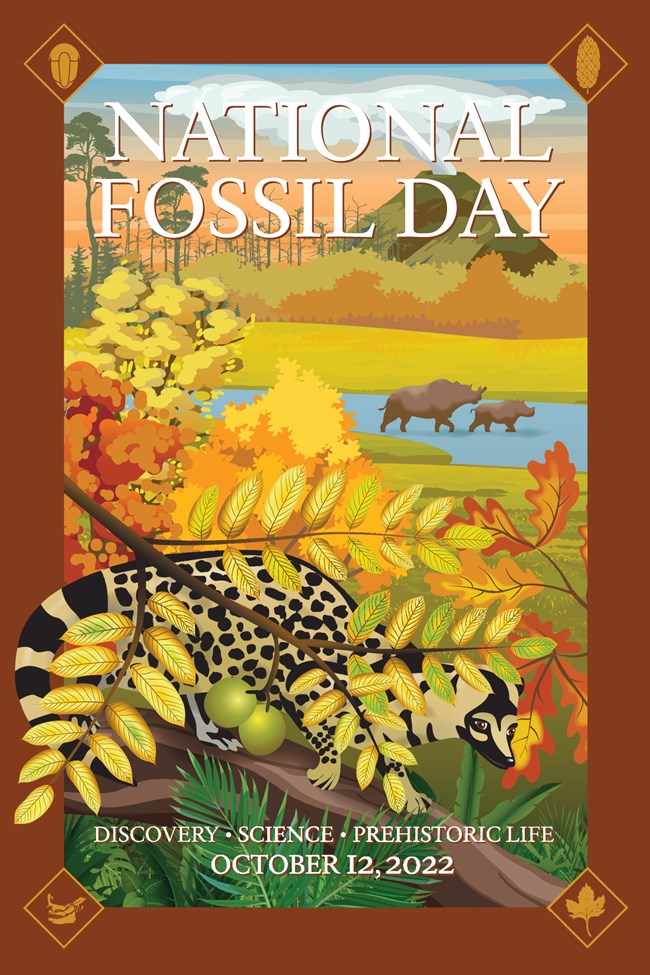
Visitors from around the world are drawn to Yellowstone National Park to see and experience the renowned geysers, hot springs, waterfalls, wildlife and other natural wonders. The park is home to a diverse assemblage of large mammals such as bison, elk, grizzly bears, and wolves. Also integral to the Yellowstone National Park experience is the widespread occurrence and diversity of geothermal features that are found throughout the park. Some of the park’s geological features have gained their own identity and fame such as Old Faithful and Steamboat Geysers, Grand Prismatic Spring, and Grand Canyon of Yellowstone. During visits to Yellowstone, it is not hard for people to be caught in the moment and inspired by these encounters of nature. These geothermal and geologic features and the biological life that lives among them at Yellowstone National Park are part of the Yellowstone Caldera, the largest "supervolcano" in North America. The Yellowstone Caldera had a major influence on the landscape and resources seen within the park today, which is an on-going and dynamic story. However, there is a far deeper natural history that extends back to the rise of complex organisms on our planet and is told through Yellowstone's fossil heritage.
Yellowstone National Park was established by the U.S. Congress and signed into law as the first National Park by President Ulysses S. Grant on March 1st, 1872. The park is largely within the northwestern corner of Wyoming, but portions of its northern and western borders lie within adjoining Montana and Idaho. The name "Yellowstone" is thought to have derived from the yellow-colored volcanic rocks called rhyolite exposed in the Grand Canyon of the Yellowstone. Archeological evidence suggests the presence of people within the Yellowstone region dating back to about 11,000 years ago. Today approximately 4 million visitors travel to see Yellowstone each year. The Yellowstone Caldera has been a major volcanic feature in the central portion of Yellowstone for over 2 million years! However, its geothermal actions also altered and obliterated much of the local deep time history prior to the caldera’s appearance. To see these pre-caldera records, we must go to the outer periphery of the Yellowstone Caldera, where sedimentary rocks and the fossils they contain can be found preserving a history of life extending back approximately 500 million years.
Some of the oldest fossils at Yellowstone National Park can be found in the middle Cambrian rocks (500 million years old) in the northwest region of the park. Ancient marine fossils of sponges, brachiopods, and trilobites were first identified in 1878 by William Henry Holmes during the Hayden expeditions in the region, making them some of the historically oldest fossils identified at Yellowstone. It should be noted here that the Hayden expeditions influenced the establishment of Yellowstone as American’s first national park.
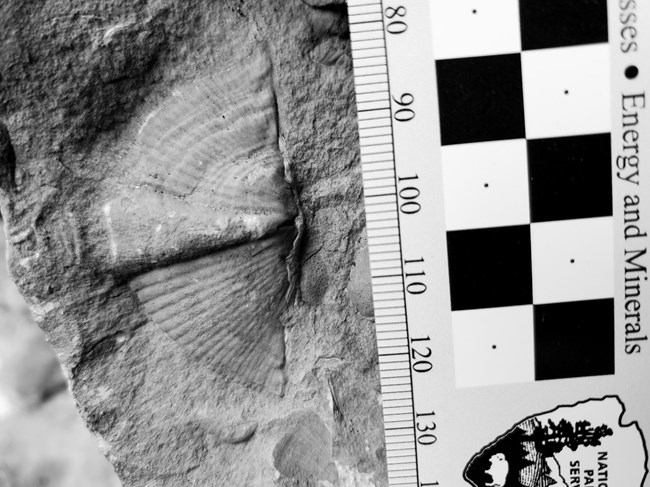
NPS Photo.
The Cambrian is the oldest geologic period of the Paleozoic Era. Younger Paleozoic rocks also occur within Yellowstone National Park such as the Late Mississippian (350 million years old) Madison Limestone, which preserves evidence of a shallow ancient seaway that included a large assortment of brachiopod species, crinoids, bryozoans, and even evidence of Helodus, an early cartilaginous fish related to the modern ratfish. The Mesozoic Era is represented at Yellowstone with geologic formations preserving Triassic, Jurassic, and Cretaceous rock strata and fossils. The Cretaceous rocks in the park include both marine and terrestrial environments preserving fossil plants, invertebrates, fish, and even dinosaurs in remote locations of the park.
The Cenozoic Era has more of a patchy fossil record in Yellowstone. Some of the best studied Cenozoic fossils from Yellowstone are from the Early Eocene (50 million years ago), existing during a time when the climate was warm and wet, supporting a forested landscape. These fossils are the inspiration for the 2022 National Fossil Day Artwork and are featured this year to celebrate the 150-year anniversary of Yellowstone National Park.
Specimen Ridge and Eocene Forests of Yellowstone
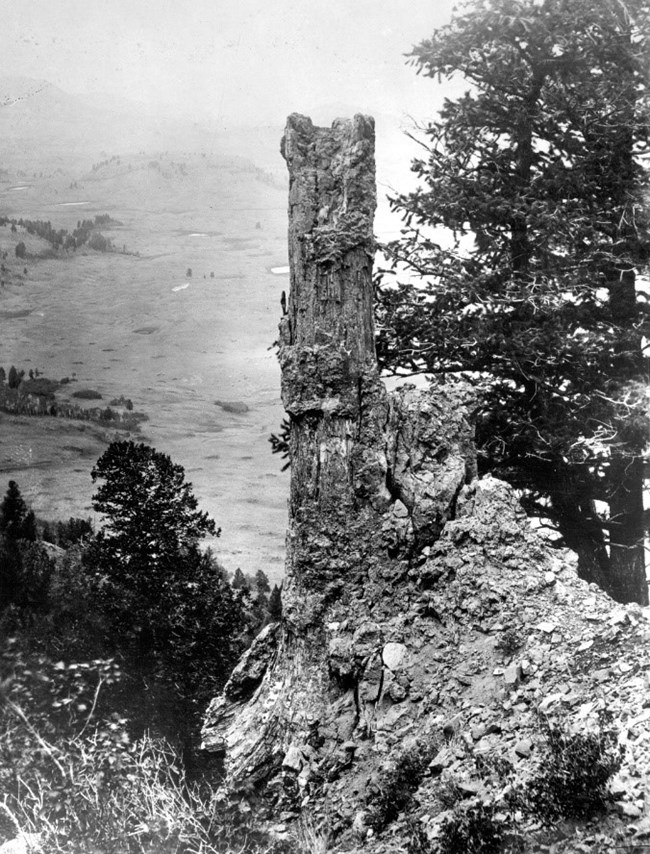
The creation of the Yellowstone Caldera was not the first time that volcanoes erupted within what is now the park; during the Eocene, there were chains of smaller volcanic cones that spanned the area. In the northeastern section of Yellowstone National Park rises Specimen Ridge, consisting of a series of volcaniclastic sedimentary rocks within the Sepulcher and Lamar River Formations. These rocks preserve a sequence of at least 27 individual Eocene petrified forests covered by volcanic ash and debris, forming the famous Yellowstone Fossil Forests. First reported in the tales shared by mountain men entering Yellowstone during the 1830s, these petrified forests have been intensely studied by paleobotanists. Paleobotany is the study of ancient plants, and Yellowstone has an amazing record for the Eocene. Not only were these trees buried in place roughly 50 million years ago, in some cases the ancient trees were buried while standing vertically in place. A large petrified tree stump is part of the driving tour at Yellowstone National Park which represent ancient conifers. Aside from petrified wood of conifer trees, fossilized leaves, cones, and nuts have also been found in these beds.
Photo (right): Historic photo of a standing petrified tree along Specimen Ridge in Yellowstone National Park.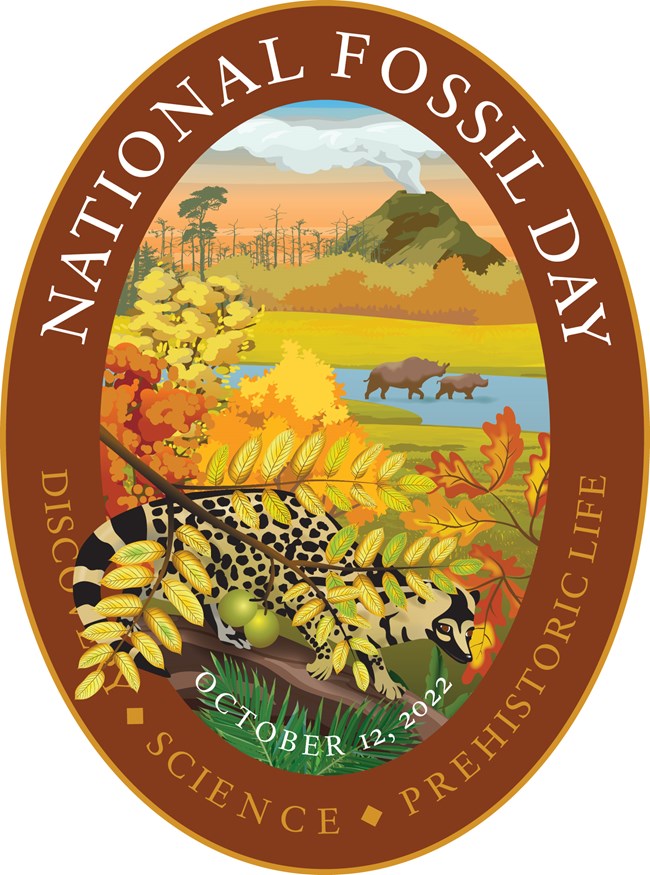
Road construction in Yellowstone during the 1990s uncovered beds of fine-grained volcanic sediments that preserved multiple types of fossilized leaves and pollen of ferns, horsetails, conifers, and flowering plants, indicating these forests were diverse in plants. Plants are an important source of information for ancient environments, in many cases much more so than animal fossils. Like plants living today, ancient plants had specific environmental requirements for survival. The Yellowstone Eocene plant fossils show that at one time this region was much warmer and moister than it is today but still had seasonal cooler periods that caused leaf fall. The 2022 National Fossil Day Artwork depicts the Yellowstone Eocene Forest with Fall coloration of the leaves of deciduous trees such as oak, poplar, and walnut. In the background, the evergreen conifers rise above the skyline while an active volcano looms in the distance which will eventually bury this valley with ash and other volcanic debris.
Prehistoric Predator in Ancient Yellowstone
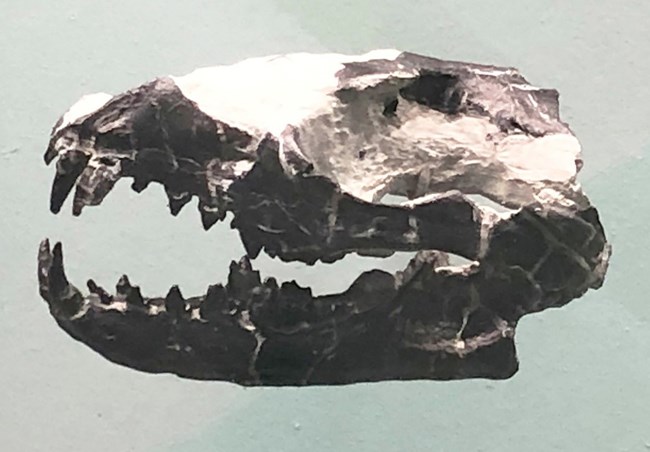
In the foreground of the 2022 National Fossil Day logo, partially concealed beneath the Eocene foliage, hides an early cousin of today’s modern carnivorous mammals. This civet-like mammal is called Didymictis, a member of a larger group of primitive meat-eating mammals called the Viverravidae. Didymictis lived throughout much the late Paleocene and early Eocene in North America and Eurasia, and were common carnivores during this time. Most viverravids did not get much larger in size than today’s foxes, and Didymictis was not much bigger than a modern house cat. It may have behaved similar to civets and mongooses today, hunting for prey on the ground or occasionally in the branches of trees. Although no fossil remains of Didymictis or other viverravids have been found directly within the park boundaries of Yellowstone, their fossils have been found not far away in other early Eocene fossil localities in northwestern Wyoming. Didymictis and its kind represent the ancient ancestral group of mammalian carnivores that would eventually lead to the ancestors of grizzly bears, wolves, pine martens, and other carnivores that live in Yellowstone today.
The large animals shown walking in the river bed on the 2022 NFD artwork are titanotheres. A titanothere is featured on the official logo for National Fossil Day. Learn more...

Left photo from John Day Fossil Bed National Monument.
Learn more about National Fossil Day and the NFD Logos and Artwork on the official National Fossil Day website
Related Links
- Yellowstone National Park, Wyoming—[Geodiversity Atlas] [Park Home] [npshistory.com]
- Geologic Time Scale
- Fossils through Geologic Time
- Rocks and Minerals
Last updated: January 12, 2024
